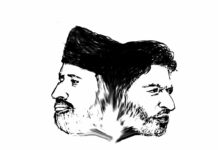Mehraj ud din
Every native in this place is engulfed and fettered with so many questions that it ended up perturbing our overall existence as a socio-psychological being. The continuous visible Indian occupation, the nihilistic subjectivity emerged from a material interpretation of life, the growing unemployment, corrupted dualistic identities, wave of irreligiousness in a religiously brimming society, the fractured educational system can turn any sane person into a werewolf. The only exception to this rule is an elite class because none of the above mentioned points are a matter of concern for them.
The idealism called “growth” in whatsoever form is a utopia in occupied territories. Freedom is a gateway to liberation, not in pejorative way but in socio-economic and intellectual context. It is only through freedom that nations evolve as a positive entity and attains liberation from the imposed socio-psychological and economic stresses which keep on haunting them day in and day out. The Indian state in post-2000 is changing the goal posts by shifting the ideological paradigms of occupation in Kashmir. Occupation has always remained physically visible but a shift to cultural and economic tinge is also playing a key role in desensitizing the natives from realizing the invisible vulnerabilities underlying of being a slave under occupation. The passive response of Indian state in last year floods and continuing silence in rehabilitating the flood affected manifests the fascist agenda of Indian state and how to want to make beggars out of Kashmir devoid of any strength and will to struggle against Indian occupation.
The very beginning of resistance starts with a living consciousness – a consciousness that Kashmir is an occupation and political parties are a means to strengthen the roots of Indian occupation in Kashmir. We must not forget that institutional development in occupied territories are agents of permeating the disease of corruption and educational hubs also work in subordination with the state policies as we recently saw in a recent brutal manifestation of state terrorism in the Kashmir University.
While as the Indian state is doing its best to maintain the occupational status-quo in Kashmir. We see a serious chasm in resistance camp whether it be on leadership level or in local resistance narratives. But the common Kashmiri who is suffocated between the rim and axis of resistance and occupation turns out the only loser in this political tussle. A common Kashmiri often asks himself why there is so much disunity in our resistance camp if there is same common ideological/political enemy. Some people argue that a common man doesn’t understand the indubitable problems inherent in different factions of resistance camp but then is it so deep and serious that one lakh deaths can’t even unite us.
What Kashmir as a nation needs is a critical engagement with the evil designs of our occupier and response from the occupant to understand his role and possible possibilities of attaining that utopia which seems a distant reality for the native. An ideological commitment with the cause should be given precedence over the emotional attachment and response which is only possible if we start understanding and analyzing both the narratives.
Mehraj ud din is a research scholar in the University of Kashmir and can be mailed at [email protected]















